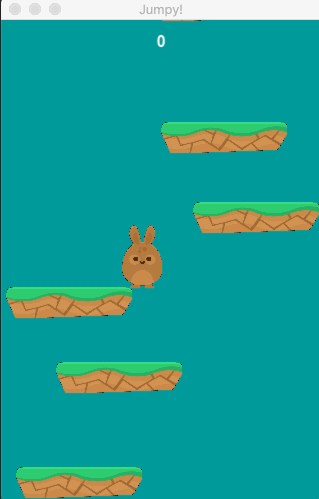pygame-KidsCanCode系列jumpy-part13-改进跳跃
这节研究下跳跃如何做得更自然,先看看之前的跳跃有什么问题,我们把settings.py里的初始化参数调整下:

1 # starting platform 2 # PLATFORM_LIST = [(5, HEIGHT - 35), 3 # (WIDTH / 2 - 50, HEIGHT * 0.75), 4 # (WIDTH * 0.12, HEIGHT * 0.5), 5 # (WIDTH * 0.65, 200), 6 # (WIDTH * 0.5, 100)] 7 8 PLATFORM_LIST = [(15, HEIGHT - 35), 9 (55, HEIGHT - 140), 10 (5, HEIGHT - 215), 11 (WIDTH * 0.70, 180), 12 (WIDTH * 0.5, 100)]
同时,把Platform类微调一下,只加载长的跳板:

1 class Platform(pg.sprite.Sprite): 2 def __init__(self, game, x, y): 3 pg.sprite.Sprite.__init__(self) 4 self.game = game 5 images = [self.game.spritesheet.get_image("ground_grass_broken.png"), 6 self.game.spritesheet.get_image("ground_grass_small_broken.png")] 7 # self.image = random.choice(images) 8 # 临时改成只使用长的跳板 9 self.image = images[0] 10 self.rect = self.image.get_rect() 11 self.rect.x = x 12 self.rect.y = y

仔细观察一下,有二个问题:
1. (当跳板上下间隔较小时)player越过第2块跳板(从下向上数,初始时,站着的那块为1),直接蹦到第3块上去了,有点不太自然,如果头顶有板的话,最好是落在最低的那块上
2.从第3块,向下落到第2块时,继续向左走,理论上应该落到第1块板上,但是无论如何,总是会被第3块板自动吸上去。
原因:连续碰到多个跳板时,碰撞检测返回的是一个被碰到的跳板数组,hits[0]返回的是最高的那块,所以总是被吸上去。
改进思路:找出最低那块,后面的就好处理了。
def update(self):
self.all_sprites.update()
if self.player.vel.y > 0:
hits = pg.sprite.spritecollide(self.player, self.platforms, False)
if hits:
# 当player向上同时碰撞到多个跳板(注:跳板之间挨得很近时,容易出现这种情况)
# 找出最低的那块,让player落上最低的跳板上
lowest = hits[0]
for hit in hits:
if hit.rect.bottom > lowest.rect.bottom:
lowest = hit
if self.player.pos.y < lowest.rect.bottom:
self.player.pos.y = lowest.rect.top
self.player.vel.y = 0
...
改进后的效果:

搞定这个,还有一个小问题:

当player走到跳板边缘时,实际上确实发生了碰撞(从垂直方向上看,player的身体与跳板有重叠,即碰撞),但从视觉上看,双脚已经离开跳板了,应该向下掉,看上去不太真实。
改进办法:
发生碰撞时,对比player.centerx(角色的x轴中心点)与跳板的left/right值,只有x轴中心点未离开跳板时,才认为真正发生了碰撞。
仍然是修改刚才的碰撞检测代码:(注:具体实现时,下面的代码在两侧保留了5px的余量,大家可以调整下这个值,以控制检测的灵敏度)
def update(self):
self.all_sprites.update()
if self.player.vel.y > 0:
hits = pg.sprite.spritecollide(self.player, self.platforms, False)
if hits:
# 当player向上同时碰撞到多个跳板(注:跳板之间挨得很近时,容易出现这种情况)
# 找出最低的那块,让player落上最低的跳板上
lowest = hits[0]
for hit in hits:
if hit.rect.bottom > lowest.rect.bottom:
lowest = hit
if self.player.pos.y < lowest.rect.bottom:
# fix 走到跳板最边缘时,仍挂在半空中,不掉下去
if lowest.rect.right + 5 >= self.player.rect.centerx >= lowest.rect.left - 5:
self.player.pos.y = lowest.rect.top
self.player.vel.y = 0
...
效果:

最后一个可以改进的地方,玩过超级玛丽的大概还记得这么一个细节:跳跃时,如果空格键按得比较重,会跳得较高,反之如果轻轻按一下,马上松开,跳跃的高度相对就很少。
分析一下其中的原理,其实按键较重时,『按下的时间』相对轻轻一按马上抬起,会略长一点。所以,关键在于KEYUP事件,只要在该事件中,想办法快速终止跳跃,自然向上跳的高度就小。
在event事件中,先添加对KEYUP的响应:

1 def events(self): 2 for event in pg.event.get(): 3 if event.type == pg.QUIT: 4 if self.playing: 5 self.playing = False 6 self.running = False 7 if event.type == pg.KEYDOWN: 8 if event.key == pg.K_SPACE: 9 self.player.jump() 10 # 按键松开时,强行中断跳跃 11 if event.type == pg.KEYUP: 12 if event.key == pg.K_SPACE: 13 self.player.jump_cut()
然后在Player类中,新增jump_cut函数:

1 def jump_cut(self): 2 if self.jumping: 3 # 给1个很小的正向速度,让其下降 4 self.vel.y = 1
如果觉得vel.y=1这样有点粗暴(相当于把上升直接骤变为下降),也可以改进成下面这样:

1 def jump_cut(self): 2 if self.jumping: 3 if self.vel.y < -3: 4 self.vel.y = -3
即:如果上升过快(即向上跳的速度过大),则让它变成一个较小的速度-3px,这样从视觉上看运动过程要连贯一些。
此外,jump函数中,也要结合self.jumping标志位一起判断,同时要设置jumping标志位的值:

1 def jump(self): 2 hits = pg.sprite.spritecollide(self, self.game.platforms, False) 3 # 加入状态位判断 4 if hits and not self.jumping: 5 self.vel.y = -PLAYER_JUMP 6 if abs(self.vel.x) < 0.5: 7 self.jumping = True
另外,在下落停在档板上时,需要把jumping状态设置为False(main.py中的update函数里微调):

1 def update(self): 2 self.all_sprites.update() 3 if self.player.vel.y > 0: 4 hits = pg.sprite.spritecollide(self.player, self.platforms, False) 5 if hits: 6 lowest = hits[0] 7 for hit in hits: 8 if hit.rect.bottom > lowest.rect.bottom: 9 lowest = hit 10 if self.player.pos.y < lowest.rect.bottom: 11 if lowest.rect.right + 5 >= self.player.rect.centerx >= lowest.rect.left - 5: 12 self.player.pos.y = lowest.rect.top 13 self.player.vel.y = 0 14 # 停下后,修改状态位 15 self.player.jumping = False
效果如下:

源码:https://github.com/yjmyzz/kids-can-code/tree/master/part_13
出处:http://yjmyzz.cnblogs.com
本文版权归作者和博客园共有,欢迎转载,但未经作者同意必须保留此段声明,且在文章页面明显位置给出原文连接,否则保留追究法律责任的权利。




